
Dr John Studley (JS) spoke to Heather Johnson (HJ) from Merck ahead of Heather’s presentation at our Organic Process Research & Development Conference.
JS – The Science paper describing the design of a biocatalytic cascade for the manufacture of Islatravir (Science 2019, 366, 1255,) published by Merck and Codexis at the end of last year, represents a landmark achievement in industrial pharmaceutical processing. Can you tell us a little about the background of this work and what to expect in your presentation?
HJ – Islatravir is a HIV reverse transcriptase translocation inhibitor currently being evaluated in Phase 3 clinical trials. Taking advantage of the similarities of islatravir to natural nucleosides, a highly selective biocatalytic API-forming step was developed. We then utilized biocatalysts to efficiently synthesize the chiral precursors to the API, ultimately leading to a fully biocatalytic cascade to synthesize islatravir. The presentation will feature an overview of the cascade, as well as a deeper look into an oxidation step, which was arguably the most challenging step during development.
JS – The manufacturing route to Islatravir has to be at the pinnacle of what can be achieved using biocatalysis and directed enzyme evolution. At what point did Merck committ to this process?
HJ – Merck is committed to the use of green chemistry, and identified biocatalysis and directed evolution as enabling technologies for the development of green new routes to complex targets several years ago. This strategic decision enabled us, along with our collaborators at Codexis, to tap into the potential of combining biocatalysis and chemistry for the synthesis of islatravir. Multiple routes using traditional synthetic chemistry were investigated in parallel (look out for some of these in upcoming publications!), but the biocatalytic cascade was the most convergent and atom-efficient. Therefore, it was a straightforward choice to select this process once proof of concept was achieved.
JS – Where do you see industrial biocatalysts going in the next decade? What challenges need to be resolved?
HJ – Industrial biocatalysts are a hugely enabling technology, and we anticipate their use in solving a wide range of problems across the pipeline (e.g. rapid access to SAR in the discovery space). Furthermore, for large molecule targets, more complex and lengthy syntheses are required; the selectivity and tunability of biocatalysts mean that these may be ideal for efficiently building these complex molecules. An ongoing challenge in utilizing biocatalysts in processes is the timescales of directed evolution (currently 2 – 4 weeks per round of evolution). Therefore, an early commitment to evolution is needed to successfully implement biocatalysis in a timely manner. Other challenges in using biocatalysts involve solvent incompatibility between the enzymes and organic substrates, and product separation from residual protein. Strategies such as enzyme immobilization have been used to tackle both of these problems, but further development is still needed.
JS – Can you tell me about your role at Merck?
HJ – I work in the Catalysis group within Enabling Technologies in Process Research & Development at Merck’s Rahway site in NJ. Our group works closely with process chemistry teams to develop and understand catalytic transformations to be used in the commercial manufacturing routes for complex pharmaceuticals. We also develop new catalytic capabilities and technologies to be implemented in the pipeline.
JS – Who inspired you to become a scientist?
HJ – I was fortunate enough to have excellent teachers and mentors throughout my education who encouraged me to apply for new opportunities. In particular, I was incredibly lucky to learn undergraduate inorganic chemistry from Professors Jennifer Green and Luet Wong at the University of Oxford, UK, which led to me pursuing research in organometallic chemistry, a decision I’m very grateful for!
and now for a bonus question…
JS – Finally-I have to ask- is a distant relative of yours the current prime minster of the United Kingdom? J
HJ – I’m also British, but no relation as far as I’m aware!








